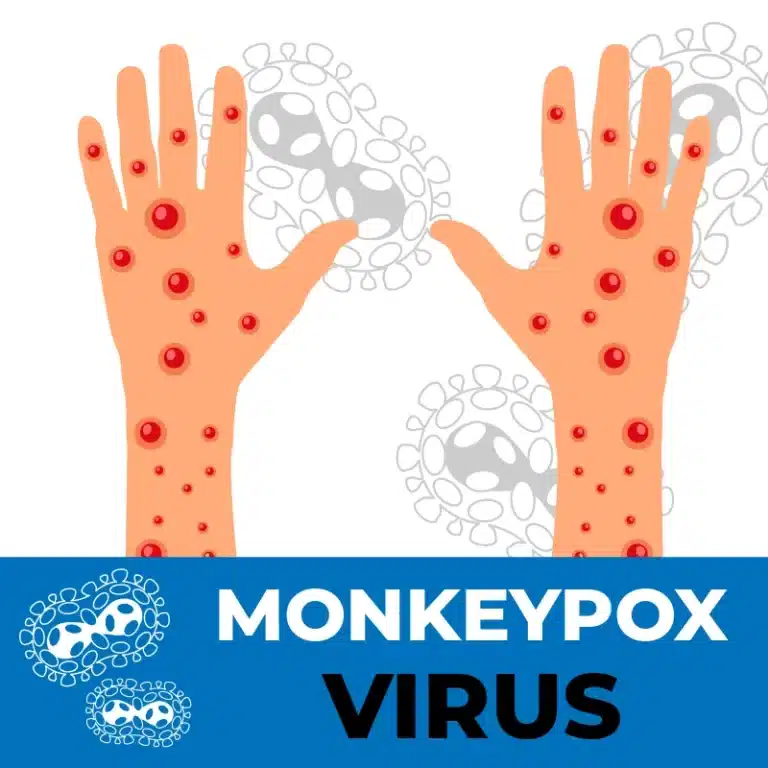A major monkeypox outbreak and monkey symptoms that has spread to at least 20 countries has prompted several notable infectious disease experts to call for swifter action from global health authorities.
The sudden and unforeseen manifestation of Monkeypox symptoms outside endemic nations indicated that transmission had occurred unnoticed for a certain duration. The exact period during which it went unreported remained unclear.
On June 9, 2022, the city of Sao Paulo in Brazil reported the country’s first case of the monkeypox virus. In Sao Paulo, another potential monkeypox case is being examined, involving a 26-year-old woman who is currently hospitalized. Meanwhile, the US Centers for Disease Control and Prevention reported that global instances of the monkeypox virus had topped 1,000, urging people to take extra precautions.1
According to the CDC, 1,019 confirmed and suspected cases of Monkeypox had been reported in 29 countries as of June 6. According to CNBC, the United Kingdom has the highest instances, with 302 suspected and confirmed illnesses, followed by Spain (198), Portugal (153), and Canada (80).2
In a speech, World Health Organization Director-General Tedros Adhanom Ghebreyesus urged impacted countries to identify all cases and contacts to manage the outbreak. Global health professionals, on the other hand, have raised concern about the rising outbreak in non-endemic countries. According to the WHO, numbers are expected to climb as surveillance improves.

What is Monkeypox and what are the Monkeypox Symptoms?
Monkeypox is a viral zoonosis, meaning it transfers from animals to humans, with symptoms resembling but less severely than smallpox. Since the eradication of smallpox in 1980 and the suspension of smallpox vaccination, Monkeypox has become a significant orthopoxvirus in public health. Its emergence has prompted increased attention due to similarities with smallpox.
Monkeypox is primarily located in Central and West Africa, especially near tropical rainforests, yet there is a growing incidence of cases in urban areas.
History of the Outbreak
Human Monkeypox was discovered in a 9-month-old boy in 1970, in a region where smallpox had been eradicated in 1968. Since then, most cases have been recorded from the Congo Basin’s rural rainforest regions, mainly in the Democratic Republic of the Congo. In addition, human cases have been reported from central and West Africa.
The cases of Human Monkeypox have been reported in 11 African nations since 1970: Benin, Cameroon, Central African Republic, DRC, Gabon, Cote d’Ivoire, Liberia, Nigeria, Republic of Congo, Sierra Leone, and South Sudan. However, the real extent of Monkeypox’s impact is unknown yet.
Monkeypox poses a global public health concern as it impacts nations in West and Central Africa and beyond. The United States experienced its first monkeypox outbreak outside of Africa in 2003. It was linked to contact with infected pet prairie dogs. This event highlighted the potential for the virus to extend beyond its traditional geographic range. Over 70 cases of Monkeypox were reported in the United States as a result of this outbreak.
Transmission of Monkeypox
The disease can be transmitted in the following ways:
Many animals in Africa have been infected with the monkeypox virus. The patients observed was rope squirrels, tree squirrels, Gambian poached rats, dormice, and other monkey species. Monkeypox’s natural reservoir has yet to be established, while rats are the most likely suspect.
- Direct contact with the blood, body fluids or cutaneous or mucosal lesions of infected animals can result in animal-to-human (zoonotic) transmission.
- A possible risk factor is eating undercooked meat and other animal products from infected animals.
- People who live in or near forested regions may be indirectly exposed to infected animals.
- Close contact with infected people, animals, or objects spreads the virus. Broken skin, the respiratory tract, the eyes, nose, and mouth are where it might enter the body.
- Droplet respiratory particle transmission typically necessitates prolonged face-to-face contact, putting health workers, household members, and other close contacts of active cases in danger.
- Transmission can also happen via the placenta from mother to foetus; Although at the same time, physical contact is a risk factor for transmission, it is currently unknown if Monkeypox may be transferred sexually.
Furthermore, more research is required to understand this risk better.
Symptoms of Monkeypox
The following are the disease’s signs and symptoms:
Monkeypox has an incubation period ranging from 6 to 13 days from infection to the beginning of symptoms.
There are two stages to the infection:
- Fever, severe headache, lymphadenopathy, back discomfort, muscle aches, and lack of energy (which lasts between 0 and 5 days). Further, Monkeypox has a specific trait of lymphadenopathy (chickenpox, measles, smallpox).
- The skin eruption usually starts 1–3 days after the fever appears. The rash focuses more on the face and extremities than the trunk. The face, palms of the hands, and soles of the feet are all affected. The number of lesions might range from a few to thousands.
Monkeypox is normally a self-limiting condition, with symptoms lasting between two and four weeks. However, severe instances are more common in youngsters and are linked to the amount of virus exposure. The patient’s condition, and the type of problems. In addition, immune inadequacies may play a role in the result. Even though smallpox vaccination was protected in the past, persons younger than 40 to 50 years should take precautions. Because that age is may now be more susceptible to Monkeypox. It is important due to the global halt of smallpox immunization campaigns following the disease’s eradication.
Therefore, vaccines protect people who might be exposed, like healthcare professionals, in the few regions where they are available. According to Sylvie Briand, the WHO’s director of epidemic and pandemic preparation and prevention, the smallpox vaccine might be used with high efficacy against Monkeypox, a companion orthopoxvirus.
The WHO attempts to ascertain how many dosages are now accessible and producers’ manufacturing and distribution capacities.
Conclusion
Now, if a doctor thinks a person might have Monkeypox, they have to tell the local council or the Health Protection Team. Monkeypox is officially considered a notifiable infectious illness by the UK Health Security Agency. Also, if a lab finds the monkeypox virus in a sample, they need to get in touch with the UK Health Security Agency. This helps authorities keep track of and manage Monkeypox cases more effectively.
Source-







